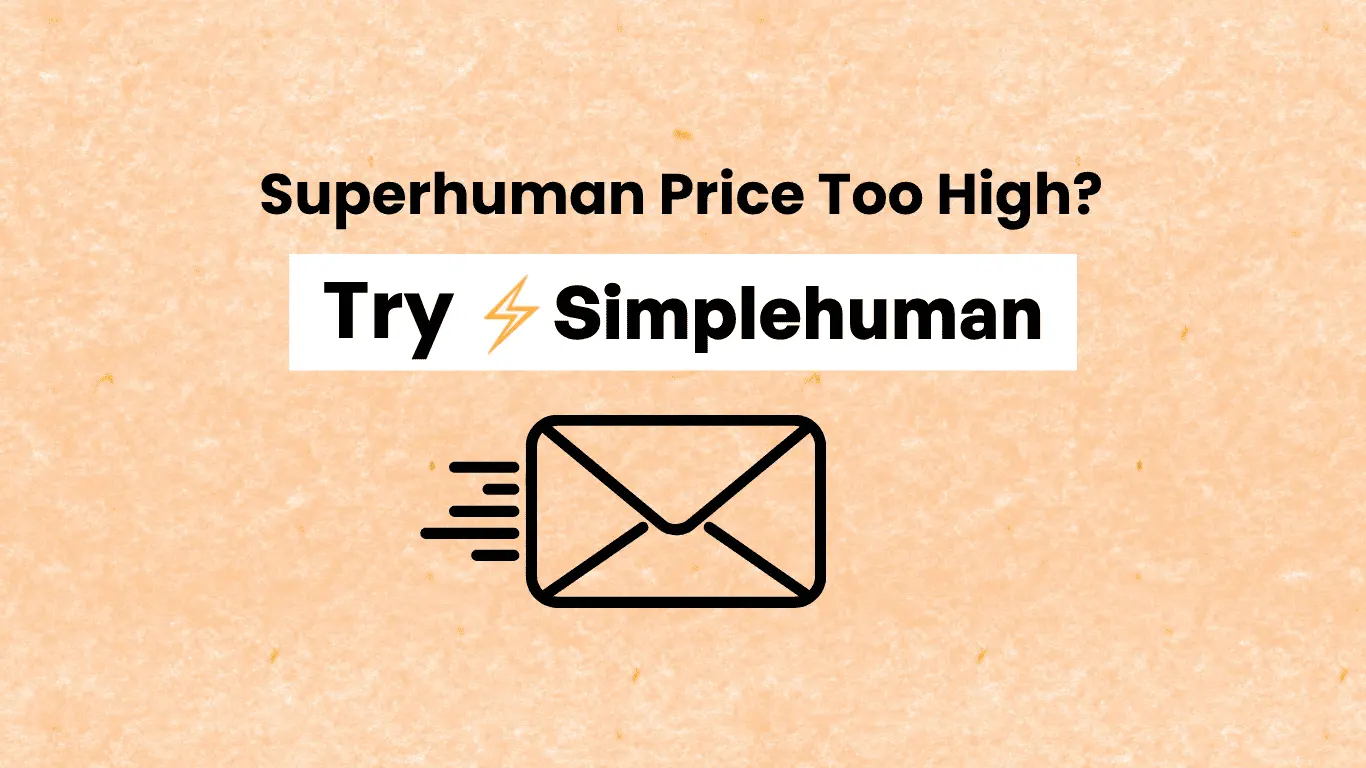If you are like most of the professionals, then chances are you’ve heard somewhere about the inbox zero trick and thought “yeah, right.” The thought of having quite literally zero emails in my inbox is as realistic as having zero things on your task list or zero notifications on your phone.
But here’s the thing, inbox zero isn’t just some productivity guru fantasy. It’s a working strategy that can completely change how you handle your emails. And with the right method (and the right tools), it’s actually way more doable than you might think.
The problem is that the majority of individuals attempt to work inbox zero using only gmail that landed them in email hell originally. That’s attempting to do a marathon in a pair of slippers, which is theoretically possible, but it’s not the proper way to do it.
What inbox zero really means (hint: it’s not what you think)
Inbox zero doesn’t mean you never ever receive any emails or that you respond to everything instantly. And it definitely doesn’t mean you become some kind of email-obsessed weirdo who likes to check their inbox every thirty seconds.
The zero inbox approach is quite straightforward, actually: your inbox is a short-term space instead of a holding area. Any email that arrives there is processed, meaning that you must decide what to do with it and send it somewhere else.
Conceptualize it as your physical mailbox. You never leave mail lying in there for days or weeks. You remove it, determine what to do with it, and take action on it or push it aside. Your Gmail inbox should function the same way.
The advantage of this method is that it gets rid of that nagging sensation of having “stuff” looming over your head all the time. When you come to your inbox and you have zero messages and you know there’s nothing that needs your attention urgently, It’s like having a perfectly tidy desk – everything is in its place, and everything has its place.
Why traditional email management fails
Before we discuss how to get inbox zero in Gmail, let’s address why everyone’s email system is an absolute mess.
The largest error you can possibly commit is using your inbox as a cabinet, to-do list, and reference library. Most people read their email and go “I’ll get around to this eventually,” and just leave them there. Gradually this builds up to the point of being too much to handle with so many emails left “to get around to.”
Scale that up to hundreds or thousands of emails, and you’re carrying around serious cognitive overload.
The other problem is that most people check email way too often. They’ll open Gmail, scan through a few messages, maybe read one or two, and then close it again. This creates the illusion of “doing email” without actually processing anything.
The simple system that makes inbox zero Gmail actually work
Here’s the system that changed everything for me (and thousands of other Simplehuman users). It’s embarrassingly simple, but incredibly effective.
Each time you open an email, you make one of four choices:
Delete it. That means newsletters you never opened, app alerts from programs you never use, spam, and anything else you don’t need to do anything about. Be brutal here – if you haven’t responded to a newsletter in the last month, you’re not going to now.
Do it now. If the email takes less than five minutes to deal with entirely, just do it immediately. This involves fast responses, basic confirmation, and straightforward tasks. Don’t overanalyse – just knock it out.
Delegate it. Send emails that another person needs to deal with. This could be sending a customer question on to your support team or sending a tech question on to your programmer.
Defer it. For emails that take over five minutes or must be dealt with at a certain time, take them out of your inbox and plan on addressing them later.
The trick is to make this choice with each and every email. No exceptions. No “I’ll get around to that later.” Each email is dealt with from start to finish before you move on to the next.
How Simplehuman makes zero mailbox actually work
Now things get interesting. You can definitely do inbox zero with Gmail’s native functionality, but it’s like eating soup with a fork – possible to do, but uncomfortably painful.
Simplehuman turns your Gmail into a real productivity tool rather than a mere email repository. The command bar (Ctrl+K or Cmnd+K) allows you to perform many email operations without even leaving your keyboard. Rather than browsing through menus or memorizing esoteric keyboard gmail hotkeys, you simply type what you want to do and our suggestion will guide you to the appropriate actions.
Natural language snooze is a revelation for the “defer” aspect of the system. Rather than attempting to decipher Gmail’s convoluted snooze email functionality, you simply press B and tell it “remind me about this next Monday.” Simplehuman takes care of the rest.
But the magic truly comes with the improvements in speed. When you can archive, delete, label, and reply to emails at thought speed, working through your inbox is a snap. What once took an hour of email handling will now only take 15 minutes.
The nudging system assists you in overcoming the mouse habit that is slowing down email processing. Each time you go for your mouse, Simplehuman reminds you of the keyboard shortcut that you could have used in its place. It is like having a productivity coach integrated into your browser.
Getting started when you have thousands of emails
If you have a huge email backlog, don’t attempt to process them all at once. You’ll exhaust yourself before you can make significant headway.
Instead, employ the “email bankruptcy” strategy. Move all emails older than 30 days into an archived folder, and begin anew with only the newer emails. This provides you with a fresh starting point while still having the old emails searchable when necessary.
Most of those past emails will be entirely irrelevant in any case. The psychological impact of beginning with a small set of emails is enormous – rather than defeated before you’ve even begun, you’ll feel that inbox zero is within reach.
The three-times-a-day rule
One of the largest mindset adjustments for inbox zero Gmail is eliminating the constant checking of email. Rather than leaving Gmail open throughout the day, assign three specific times to process email:
Morning (approximately 9 AM): Take 15-20 minutes to process all that arrived overnight. This establishes a clear beginning to your day and helps you avoid missing anything that is urgent.
Midday (about 12:30 PM): A 10-minute speed check to tackle whatever urgent matter requires attention at this time. The majority of the days, this will be only a handful of messages.
End of day (about 5 PM): Another 15-20 minutes to clear the afternoon’s mails and set tomorrow up.
That’s it. Three times a day, for roughly 45 minutes total. Otherwise, Gmail remains shut down. This cuts off the temptation to “just check quickly” every few minutes, which kills your concentration on real work.
Common mistakes that kill your progress
The greatest error is to attempt to organize all of it neatly. Individuals spend far too much time making perfect folder hierarchies and tagging systems. Most emails are not in need of sophisticated organization – they just need to be dealt with and cleared from your inbox.
Another pitfall is retaining emails “just in case.” Delete an email unless you have some reason to save it. Gmail’s search capability is incredibly robust – if you need to find something later, you can simply search for it.
The third error is creating exceptions for “priority” emails. Every email is a priority when you’re opening it up. Follow your system. If an email requires action, move it into your action folder and block time to deal with it properly.
Why inbox zero in Gmail changes everything
The immediate advantage is more effective email management. But the true payoff goes much deeper.
Once you stop worrying so much about your inbox, you can keep your attention on other work for longer stretches. Your stress level decreases significantly. You’re more attentive to genuinely important emails because they’re not lost amidst dozens of others.
Making it stick long-term
The largest problem with the zero inbox approach isn’t how to learn the system – it’s keeping at it when life gets hectic.
Protect your processing times on email. These 45 minutes are not negotiable. Prioritize them like special meetings that cannot be rescheduled.
Do a weekly check-in. Each Friday, take 10 minutes to check your email system. Are there patterns emerging in the emails you’re receiving? Are there repeat issues you can address ahead of time?
If you’re frustrated with email anxiety and want to get your digital life in order, I’d suggest you try Simplehuman. You can download it from the Chrome Web Store here.
The blending of inbox zero philosophy and Simplehuman’s productivity tools results in a system that finally works for busy professionals like me. No more email anxiety, no more key messages being lost, no more wasting hours on email organization.
And obviously, as Simplehuman’s founder, I’m always available if you need to ask anything or give me any feedback. I’d love it if you could use this as the ultimate Gmail productivity solution for business professionals who want to reach inbox zero without going crazy.
Write to us at [email protected] or install Simplehuman from the Chrome Web Store to be on your way to inbox zero today.








